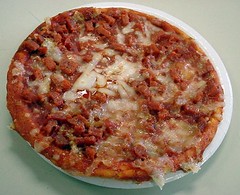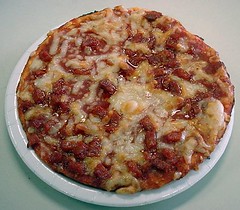I admit, I'm not a big fan of microwave ovens. I have one in my kitchen, like just about everyone else, but I don't put it to much use - heating frozen or canned vegetables, mostly. I hate the texture most things get when they're "cooked" in the microwave, and I don't think that the savings in time is worth the dramatic decrease in quality of the finished product.
Recently, though, some companies have introduced recipe changes in their manufactured prepared foods that have made products better suited for microwaves. Pot pies, for example. I used to hate pot pies cooked in the microwave because the crusts came out so badly. But recently, Banquet and Marie Callendar pot pies seem to have tweaked the way their crusts are made - I honestly couldn't tell the difference between a microwaved and a baked pot pie the last time I had them.
 And that got me to thinking about frozen pizzas. When I was a kid, frozen pizzas were the bottom of the frozen-food barrel. Nasty in all ways - the crusts were flavorless cardboard, the sauce was cheap, acidic, and rarely seasoned with anything but too much oregano, and the cheese was like plastic. Nowadays, though, there are some really decent frozen pizzas out there. Just about all of them are better when cooked in a conventional oven, though.
And that got me to thinking about frozen pizzas. When I was a kid, frozen pizzas were the bottom of the frozen-food barrel. Nasty in all ways - the crusts were flavorless cardboard, the sauce was cheap, acidic, and rarely seasoned with anything but too much oregano, and the cheese was like plastic. Nowadays, though, there are some really decent frozen pizzas out there. Just about all of them are better when cooked in a conventional oven, though.The first time I ever tried heating frozen pizza in a microwave, it was a Celeste Pizza For One. Even given the generally low quality of Celeste pies to begin with, it was horrible. The cheese was hard and brownish-yellow, the crust leathery and unchewable, and enough of the moisture had evaporated from the sauce to render it into a kind of tangy red tar. Microwaves were just getting wide acceptance then, and food companies were starting to adapt their products to this new way of ruining dinner.
This week, with Celeste Pizzas For One selling for a dollar each at the local Stop & Shop, I picked up a couple of them and decided to do a head-to-head comparison of cheap frozen pizzas cooked in the microwave and in a conventional oven. I picked the Pepperoni variety and followed the package directions to the letter.
 Microwave Instructions: Remove frozen pizza and microwave disk from carton; unwrap. For best results, do not add additional toppings. Cetner disk, silver side up, on microwave-save plate. Place frozen pizza on disk. Place plate in microwave oven. Microwave on HIGH (100%) power 3½ to 4½ minutes, or until most of the cheese is melted, rotating ¼ turn after 2 minutes. Carefully remove pizza from oven. Loosen pizza from disk with spatula.
Microwave Instructions: Remove frozen pizza and microwave disk from carton; unwrap. For best results, do not add additional toppings. Cetner disk, silver side up, on microwave-save plate. Place frozen pizza on disk. Place plate in microwave oven. Microwave on HIGH (100%) power 3½ to 4½ minutes, or until most of the cheese is melted, rotating ¼ turn after 2 minutes. Carefully remove pizza from oven. Loosen pizza from disk with spatula.Result: The package instructions were clear and easy to follow, and did produce a somewhat evenly-heated and acceptable pizza. The cheese melted well but also tended to dehydrate a bit, leaving it translucent and stiff. And because the microwave made the sauce bubble up from the crust, the already-stingy application of cheese looked even less generous as it became hidden beneath a layer of bubble-pocked redness.
The microwave disk definitely helped make the crust crispy, and it was far better than that first one years ago, but it's clear they have a long way to go here. The edges were crunchy, but coming in from the edges the crust was dense and tough, and parts here and there were dehydrated.
 Conventional Oven Instructions: Place baking sheet on center oven rack; preheat oven to 400F. Remove frozen pizza from carton; unwrap. Place frozen pizza on PREHEATED baking sheet. Bake 11 to 13 minutes or until center cheese is melted and crust edge is golden brown. For extra crisp crust: Place frozen pizza directly on center oven rack. Bake as directed.
Conventional Oven Instructions: Place baking sheet on center oven rack; preheat oven to 400F. Remove frozen pizza from carton; unwrap. Place frozen pizza on PREHEATED baking sheet. Bake 11 to 13 minutes or until center cheese is melted and crust edge is golden brown. For extra crisp crust: Place frozen pizza directly on center oven rack. Bake as directed.Result: The cheese was much more evenly melted, without and dehydrated, plasticy areas. The sauce stayed put, bubbling a bit but not pushing its way up through the cheese. Parts of the cheese got golden brown on the surface.
The crust was much nicer on the baked pizza - crispy, but also flaky and tender, with a toasted edge. Although not as agressively crunchy as the microwaved version, it was pleasantly toasted around the edges.
One other thing I noticed: I timed the cooking phase so that each pizza would come out of the oven and be served at the same time. Both of the pies were cooked exactly to package specifications, and yet the microwaved pizza got cold faster than the conventionally-cooked one. I've noticed this in other microwaved foods as well, and it's another reason why I don't use the microwave very often.
Conclusion:
Celeste Pizza For One is still a pretty crappy frozen pizza, even if frozen pizzas themselves have gotten better over the years.
Link:
Pinnacle Food Group, Inc. holds the Celeste frozen pizza brand. The number of other familiar brands they own might surprise you.
.

I just cut a single slice out of a huge frozen pizza and cut out a matching triangle of thin aluminum foil. I place the foil onto a microwavable plate and put the pizza slice on top.
ReplyDeleteLittle or no foil exposed. Cooked in the mw for three minutes on high. It came out bubbling on top. I removed the foil and the bottom was wet but not soggy.
The very tip of the slice was dry and sort of hard. The crust was also hard but some people eat hard crusts anyway - I don't like crusts.
Once it cooled the bottom dried out somewhat and I could see that there was a slight browning.
The rest of the pizza was delicious.